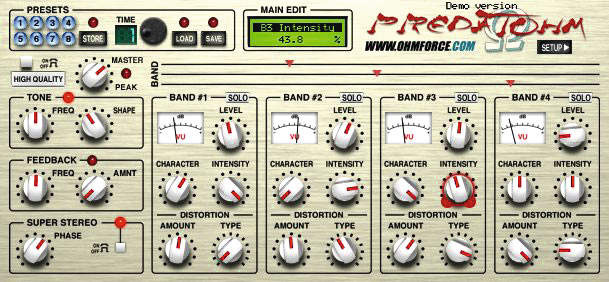MusicRadar Verdict
Ohmicide´s varied distortion types, multibanding and Melohman features make this much more than ‘just another distortion´. It´s a great addition to anyone´s setup.
Pros
- +
Variety of distortion. Superb sound quality. Easy to use. Beautiful GUI.
Cons
- -
MIDI learn is a bit fiddly.
MusicRadar's got your back

You can select a different type of distortion for each band.

Morph between presets by playing notes on your MIDI keyboard.

Ohmicide's biggest rival is Ohm's own Predatohm.
Ohmicide is a cross platform plug-in, with support for the VST, AU and RTAS formats. Though it is an effects processor, it takes advantage of Ohm Force´s Melohman technology so you´ll get the most out of it if you have a MIDI controller to hand.
It´s downloadable, and it´ll set you back a very reasonable €79. That´s for a single format. If you want them all, you´ll have to come up with €99. It´s a welcome move from Ohm Force, not forcing customers to pay for formats they aren´t going to need.
Ohmicide:Melohman´s bone-white interface represents a bit of a departure from the usual over-the-top Ohm Force design - there are no claws, cats or space aliens to be seen.
This time around, clarity is the modus operandi, though they have flexed their artistic side a little with the dried blood stains and typed logo.
Ohmicide is a multiband distortion processor, and the controls for each band are tucked away just below an informative waveform display. Global controls are dotted about the interface, and at first glance you might be surprised at the lack of marks surrounding the knobs. But not to worry - clicking one brings up an indicator that gives you an idea of that particular parameter´s value. All in all, it´s straightforward to get around and easy to understand.
Distinct bands
Ohmicide: Melohman comes with up to four distinct bands of distortion. The idea is that you break your signal down into separate frequency bands and apply individual processing to each of them. For instance, you might apply some subtle analogue-style coloration to the lowest frequency band, while at the same time slathering some harsh digital destruction on the highest frequencies, with something else entirely happening to the mid range.
Want all the hottest music and gear news, reviews, deals, features and more, direct to your inbox? Sign up here.
Each band has a dedicated gate with control over Threshold, Amount, and Attack and Release times. There´s a Shape parameter that swings between ‘phat´ and ‘sharp´ waveshaping duties, and additionally, you´re allowed control over gain, volume, feedback, feedback frequency and spread of the affected signal. Again, these parameters are per band. Each band even has its own menu for selecting one of the many available types of distortion.
Note that we said ‘types´ - Ohmicide doesn´t ask you to settle for a single distortion method, but offers no less than 27 different algorithms, each with two variations. These run the gamut from the sublime waveshaping of Soft Clip to the all-out aural attack of the sample-and-hold-based Decimator. Some, such as Puncher, do exactly what their name suggests while others, such as Angry Mouse, are given less obvious names (Angry Mouse sounds claustrophobic and filtered, by the way).
As suggested, there are three variations on each type of distortion. In addition to the Standard variety, there are also XXX and Odd versions on tap. The XXX family is ideal for strapping across guitars - to our ears, it provides a more visceral tone with some types of distortion. The Odd family adds yet another hue, often grittier than the Standard set, especially at extreme values.
Features
While the above feature set would more than justify the price of Ohmicide, the Melohman features clinch the deal. For those not familiar with Ohm Force´s Melohman technology, it allows you to set up various preset morphing behaviours for triggering via a MIDI keyboard. This allows for some interesting live interaction with the plug-in. You can, for instance, set Ohmicide up so that higher velocities cause the patch to change suddenly, while slower velocities trigger a more gradual morph.
In the past, Ohm Force have only applied this idea to synthesizers. Here, for the first time, they´ve added Melohman to an effects device, and to excellent effect. In addition, Ohmicide has MIDI learn functions that enable you to latch parameters to MIDI CCs, such as those transmitted by knobs or sliders on an external MIDI controller. Even preset selection can be assigned, which is useful for creating glitchy effects. We prefer MIDI learn that can be assigned via a simple right-click, but Ohmicide´s menu-based method is fine.
We´ve come to expect a certain level of quality from the company, and Ohmicide doesn´t disappoint. At this cheerfully low price, it´s an offer we can´t refuse.
MusicRadar is the number 1 website for music makers of all kinds, be they guitarists, drummers, keyboard players, djs or producers...
GEAR: We help musicians find the best gear with top-ranking gear round-ups and high- quality, authoritative reviews by a wide team of highly experienced experts.
TIPS: We also provide tuition, from bite-sized tips to advanced work-outs and guidance from recognised musicians and stars.
STARS: We talk to musicians and stars about their creative processes, and the nuts and bolts of their gear and technique. We give fans an insight into the actual craft of music making that no other music website can.
